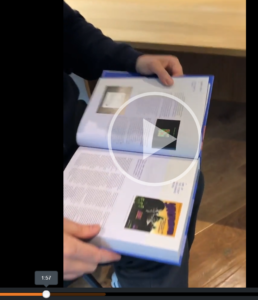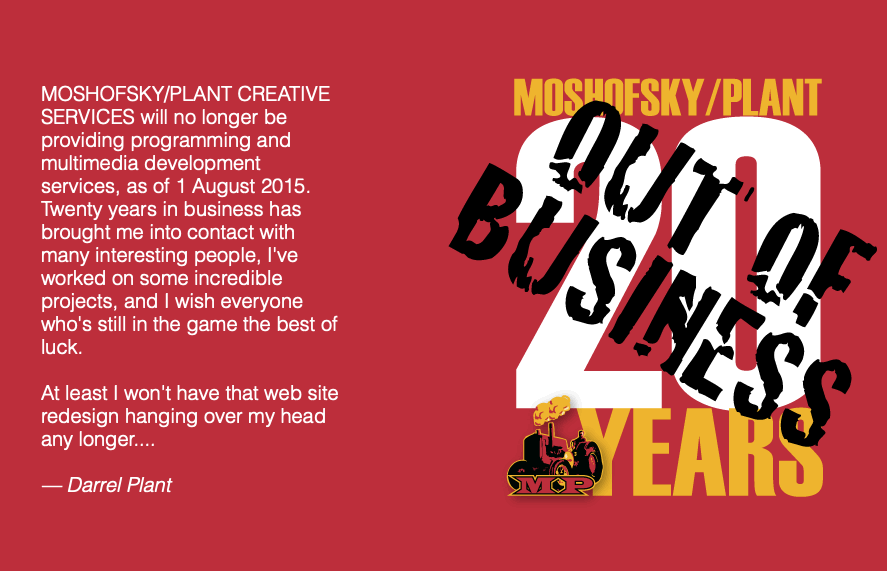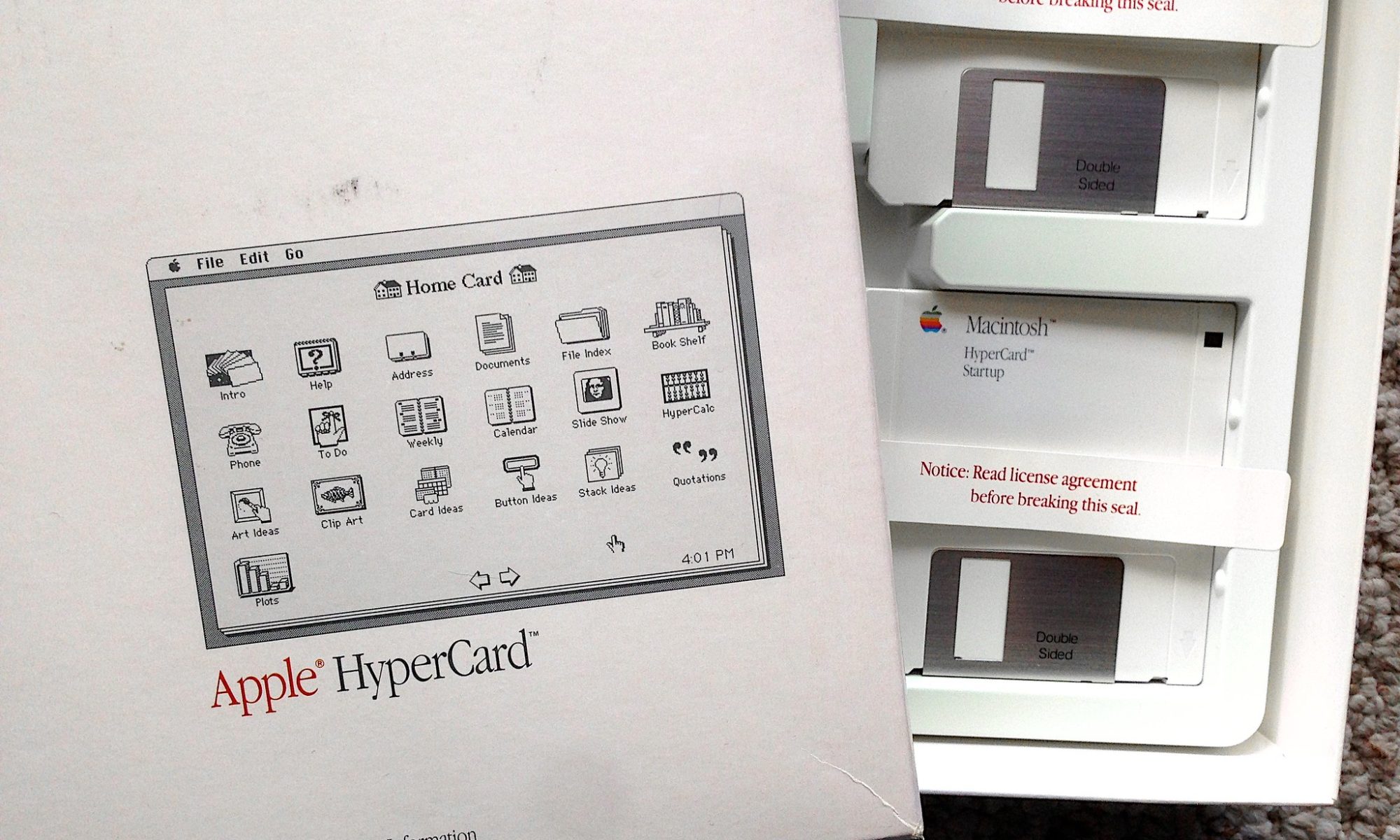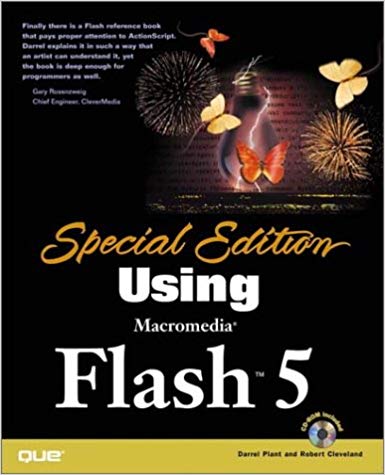Happy 28th birthday to my first domain, moshplant.com. The web site is mostly shuttered, though there’s still searchable material on there, some Macromedia/Adobe Director-related stuff, the couple of issues of Plant’s Review of Books I managed to pull out of Quark XPress before the Syquest and DAT tape drives broke down. It’s still my email domain, though, and the hub through which I run my empire.
Hypercard Dreams
In response to my post about a thread containing lots of yummy pre-Web hyper content, Alan Levine responds:
Back at the house in Arizona I have a virgin set of Hypercard 1.1 floppies circa 1987. To use them you will need a Mac Plus, SE, or Mac II, and at least 1 MB of RAM. Make sure you are running System 3.2 or later.
John Henry Hypercard
They Might Be Giants have released a commemorative version of their vintage Hypercard stack for the album John Henry, done in Flash.
Check out the old new thing! The John Henry Hypercard Stack: https://t.co/Ny31mNg0Xd pic.twitter.com/P2obtt2ZAX
— They Might Be Giants (@tmbg) October 25, 2019
The Evolution of the Digital World
Several years back, Rob Ford of the FWA contacted me to ask some questions about my minor role in the history of online multimedia for a book he had been working on. I was both flattered and flabbergasted. Like so many labors of love, there have been a number of deadlines that came and went for the project’s release, but apparently Web Design: The Evolution of the Digital World 1990–Today (Taschen) has finally reached gestation, and Phillip Kerman caught a glimpse of my first book’s cover in Rob’s unpacking video, posted on his Amazon author page.

New Here
I know I haven’t been particularly active on Adobe Support forums in recent years, but I have been using Adobe products since Illustrator 0.88, when I was at Reed College and it was in beta release more than thirty years ago. I’ve had an account on the Adobe site for probably close to two decades, and I authored multiple books on two of the products they acquired from Macromedia.
Congratulations moshplant !
As the result of your contributions to the community, you have earned a new rank.
Your new rank is New Here .
Flash Royalty
Going through the site and cleaning up some old links, I ran across a post I did on the tenth anniversary of the publication of Special Edition Using Macromedia Flash 5. That post was published eight years and one week ago, so the book is barely legal!
That post, in turn, referenced one from 2009, where I originally mentioned that the royalty statements I was still getting from the book only had me $700 in the hole to the publisher on my advance payment (the sales of the book never having earned enough to pay me a portion equal to what I’d received after completion—the advance—and sales after eight years having slowed somewhat).
In 2011, I’d provided the updated figure, which had been reduced by almost $50 over the intervening 28 months: -$658.70.
You’ll be happy to know that in the statement I have before me (yes, I’m still getting monthly printed statements even after 18 years), that baby’s still earning 12¢/month from my share of electronic subscriptions, and the intervening period has seen the balance I owe reduced to –$535.32. That’s $15.42/year even after a decade in print! So I should be even sometime around 2054.
I look forward to these monthly reminders of my mortality.
darrelplant.com Blog Engine Ends Service
More than fifteen years ago, while I was trying to learn new skills to supplant my knowledge of Director and Flash, I set out to pick up PHP and SQL by writing my own system for posting stuff on the internet, on my own domain, on my own server.
That effort didn’t exactly pay off—I spent most of the intervening years un- or underemployed—it didn’t make me a PHP/SQL savant, and by 2010 I was using WordPress to run my other blog, Mutant Poker. In the meantime, I posted a lot of political and general interest stuff here that I thought was interesting, but the system I wrote made more investment of time in it just seem counterproductive.
I’ve finally taken the time (not so much as I thought it would take) to convert the hand-built system to WordPress, figure out how to redirect all (well most) of the URLs, and get my act together, so: ta-dah! Welcome to darrelplant.com 2.0.
Go Right Ahead
So I’m watching and (obsessively) re-watching “Go Right Ahead”, the premiere video from The Hives’ new Lex Hives album, and behind Howlin’ Pelle Almqvist on the drum kit is a distracting graphic that keeps reminding me of one version of the old Macromedia Flash logos:

Nothing to do with the song.
If You Think Poker’s Risky, Try Writing Computer Books
Yesterday was the tenth anniversary of the publication of Special Edition Using Macromedia Flash 5, the book that put a cap in the eye of my career as an author of multimedia programming texts.
I’d gotten off to a bang with my Shockwave book six years earlier. It was the only book that I feel was an actual success (for me, if not for the publisher). It was supposed to be followed by a sequel that followed up on the improvements in Shockwave over the next eighteen months, but that was cancelled and my approach to a dictionary of Shockwave Lingo terms in that book turned into The Lingo Programmers Reference—probably the single most-well-received work I ever did—but which had the bad timing to hit the streets about the time the publisher was being consolidated into a new company. The birth of that monster book was difficult, I had to delve into Lingo I’d never used and try to figure out what it actually did. It went over schedule, the computer book publishers were already tightening up advances due to a glut of material, so what I was paid before publication was a lot less than I had on the Shockwave book and I never saw any royalties after publication.
My literary agent proffered me the chance to write the first official book on Flash, from Macromedia Press (he was representing them). It was a flat fee, no royalties were to be paid, it was the hot new technology. Macromedia had just bought Flash, and it was more of a design and animation tool than a programming platform at the time, so I wasn’t exactly the person you’d think of to write it, but I needed money after months of working on LPR for no return. But I found the Flash book demoralizing. I’m not a designer or an animator—at least not in any sense that really counts—and the samples I was producing looked like crap compared to the material out in the wild. Still the book probably sold more copies than anything else I ever did combined. Not that I was to see any of it. The publisher left my name on the Flash 3 version of the book but didn’t hire me to make the changes.
I worked on portions of a few other books, but the Flash 5 book was the last one I wrote more than a third of. It was supposed to be me and my office partner Peter Sylwester, with Pete handling the graphics and animation side of things and me doing programming, which had improved substantially over three years, but for various reason Pete had to leave the project and the publisher brought in Robert Cleveland to write the first half of the book. So far as I remember, I never met or even corresponded with Robert, or saw any of his material before the book shipped.
Every month for the past ten years, I’ve gotten a royalty statement from the publishing company’s parent. According to the most recent, the “Total Net Earnings Current Period” is -$658.70. That’s after ten years. The most recent statement month earned ninety-four cents. It was -$705.47 in January 2009. Just another data point in a graph of…something.
Digitized Decade 3: Flash Forward
February 19-21, 2001 was the occasion for one of the early FlashForward conferences in San Francisco, the fourth such event if my own decade-old article can be believed.
I took a number of photos at the event and published some of them at the time, but in the interests of the Digitized Decade project, here are a few people from the past.

People who made their big names in Director before Flash was around: independent developer Phillip Kerman, Macromedia stalwart John Dowdell, and Marvyn Hortman who ran an early Director file-sharing site.

Flash is smashing!: Flash’s creator Jon Gay is flanked by Glenn Thomas and Andreas Heim of Smashing Ideas.

Manuel Clement waits for a session to begin before moving on to big, big things.

Sam Wan give a talk back when he was still a college boy. Those monitors look so futuristic!
For those of you using Flash in the mobile dev world, here’s an entertaining snippet from my write-up of the event:
Flash is extending its tentacles into new platforms with the release of a player and development kit for the Pocket PC platform.
The Digitized Decade is a look back at the first year of our entry into consumer digital photography.




